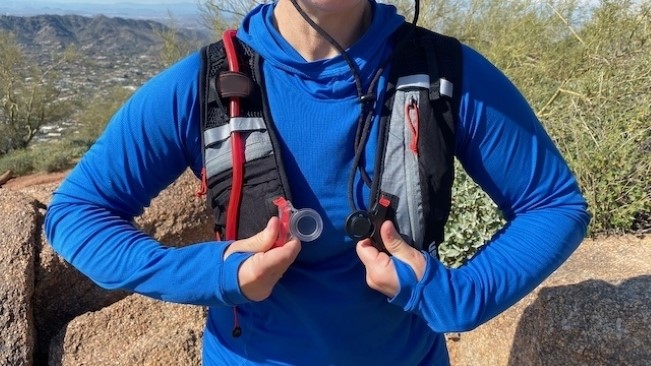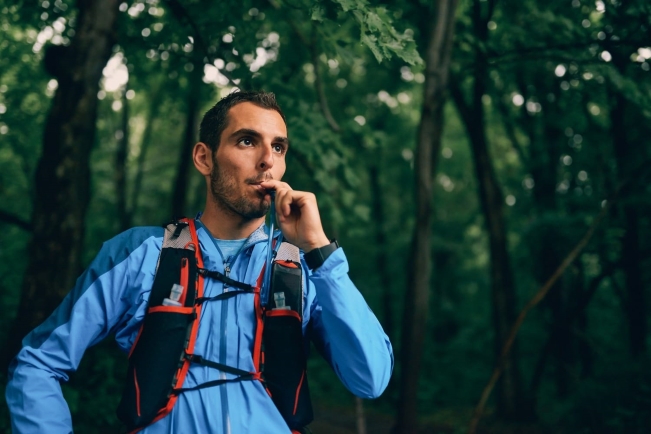Staying hydrated is essential, especially during outdoor activities like hiking, cycling, and trail running. Whether you’re pushing your limits on a mountain trail or simply enjoying a leisurely walk, having a reliable hydration system can make all the difference. But what’s the best way to carry your water?
Outdoor enthusiasts typically rely on two main options: hydration packs and traditional water bottles. Each has its own advantages, but which one is right for you? Let’s explore both options to help you make the best choice for your adventures.
Understanding Hydration Packs & Water Bottles

Before we dive into the pros and cons, let’s get familiar with our contenders.
What Are Hydration Backpacks?
In short, well-designed and durable hydration packs allow for hands-free drinking while on the move. They feature a built-in water reservoir (often called a bladder), which is connected to a drinking tube that extends to the shoulder strap for easy access. This design enables users to sip water without stopping or reaching for a bottle.
Hydration packs come in a variety of sizes, typically ranging from 1 to 3 litres in capacity, making them ideal for endurance activities where frequent hydration is necessary. The pack evenly distributes the weight of the water across the back, reducing strain on one side of the body and making it more comfortable for long treks.
These backpacks often include multiple compartments, providing storage for essentials such as snacks, first aid supplies, and extra gear. Many are also designed with ventilation and ergonomic padding to ensure comfort during prolonged use. Some hydration packs even feature insulated reservoirs to keep water cool for extended periods.
Originally designed for military and extreme sports use, hydration packs have become a go-to choice for outdoor enthusiasts, marathon runners, cyclists, and hikers. With advancements in materials and design, they now cater to a broad range of activities, from casual day hikes to ultra-endurance races.
What Are Water Bottles?
Ah, the good old water bottle—simple, reliable, and easy to use. Available in various materials like plastic, stainless steel, and glass, bottles are the go-to hydration method for gym-goers, casual hikers, and commuters. Unlike hydration packs, water bottles require manual handling, but they are easy to refill and clean.
Now that we know what we’re dealing with, let’s explore the pros and cons of each option.
The Pros & Cons of Hydration Packs and Water Bottles
No hydration solution is perfect, each comes with its own perks and drawbacks. Let’s see how they compare!
Hydration Packs:
Pros
- Hands-Free Convenience: With a hydration backpack, you can sip water on the move without stopping or using your hands.
- Large Water Capacity: These packs can carry up to 3 litres, perfect for long treks or endurance activities.
- Even Weight Distribution: Since the water sits in your backpack, the weight is balanced, making it more comfortable over long distances.
- Extra Storage: Many hydration packs have compartments for snacks, tools, and other essentials.
Cons
- More Expensive: Hydration backpacks cost more than a standard water bottle.
- Harder to Clean: The tube and bladder require thorough cleaning to prevent mould and odours.
- Heavier & Bulkier: Compared to a simple bottle, they can feel cumbersome for short trips.
Water Bottles:
Pros
- Affordable & Widely Available: From plastic to stainless steel, bottles come in various price ranges.
- Easy to Clean: A quick rinse and you’re good to go—no fiddly tubes or reservoirs to worry about.
- Lightweight & Portable: Ideal for short activities where you don’t need to carry large amounts of water.
- More Durable Options: Stainless steel bottles are tough, eco-friendly, and can keep drinks cool for hours.
Cons
- Limited Capacity: Most bottles hold only 500ml–1L, requiring frequent refills.
- Less Convenient While Moving: You need to stop or slow down to take a sip.
- Bulky to Carry: Unless your backpack has a bottle pocket, you’ll be holding it or stashing it inside.
Best Situations for Each Option

When should you choose a hydration pack, and when is a water bottle the better choice? Here’s a quick guide:
When to Choose a Hydration Pack
- Long-Distance Hiking & Trekking: If you’re on a multi-hour or all-day adventure, a hydration backpack provides easy access to water.
- Cycling & Trail Running: Hands-free drinking without breaking your rhythm? Yes, please.
- Hot Climates: When dehydration is a risk, carrying more water is always a good idea.
- Adventure Races & Endurance Sports: For marathons, triathlons, and other long events, a hydration pack is a game-changer.
When to Choose a Water Bottle
- Short Walks & Day Trips: If you’re only out for an hour or two, a bottle is more than sufficient.
- Gym Sessions & Urban Use: Easier to refill at water fountains and more practical for everyday activities.
- Casual Hiking: If you’re on a well-marked trail with plenty of refill spots, a bottle does the trick.
- Eco-Conscious Choices: Stainless steel bottles reduce plastic waste and last for years.
The Hybrid Approach: Why Not Both?
Here’s a thought, why not combine the best of both worlds? Many adventurers carry both a hydration pack and a water bottle for added flexibility.
How This Works:
- Use a hydration backpack for your main water source.
- Carry a bottle for electrolyte drinks or flavoured water.
- This method ensures you have a backup if one system fails
For example, cyclists might carry an energy drink in a bottle while using a hydration pack for water. Hikers may carry a filter bottle for refilling from natural water sources while relying on their hydration backpack for quick sips on the go.
Finishing Thoughts
So, what’s the final verdict? It all depends on your activity and preferences. If you’re tackling long distances, need hands-free access, or require extra storage, a hydration pack is the way to go. If you prefer simplicity, easy cleaning, and a budget-friendly option, a water bottle is your best bet. No matter which you choose, the most important thing is staying hydrated. Drink up and stay adventurous!
























